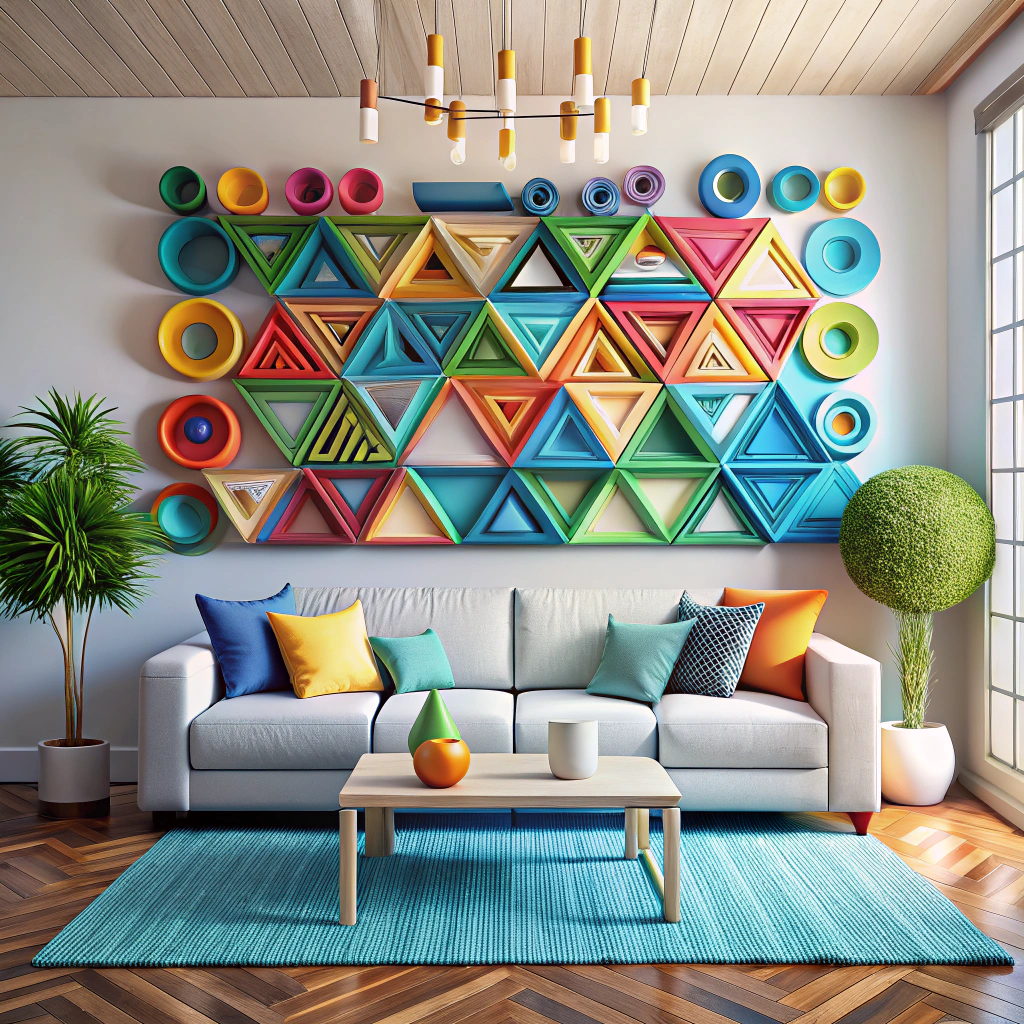Last updated on
Creating an ideal custom home office matters because it significantly influences your productivity, comfort, and work-life balance.
Key takeaways:
- Assess space and needs: Measure, consider work habits, storage, multi-purpose, tech requirements.
- Prioritize ergonomic furniture: Adjustable chair, proper desk height, keyboard trays, monitor stands.
- Optimize desk placement: Position parallel or facing window, consider proximity to door, backdrop for video conferences.
- Consider lighting options: Maximize natural light, task lighting, dimmable options, ambient lighting.
- Personalize your office space: Add personal touches, artwork, plants, storage solutions, desk accessories.
Assessing Your Space and Needs
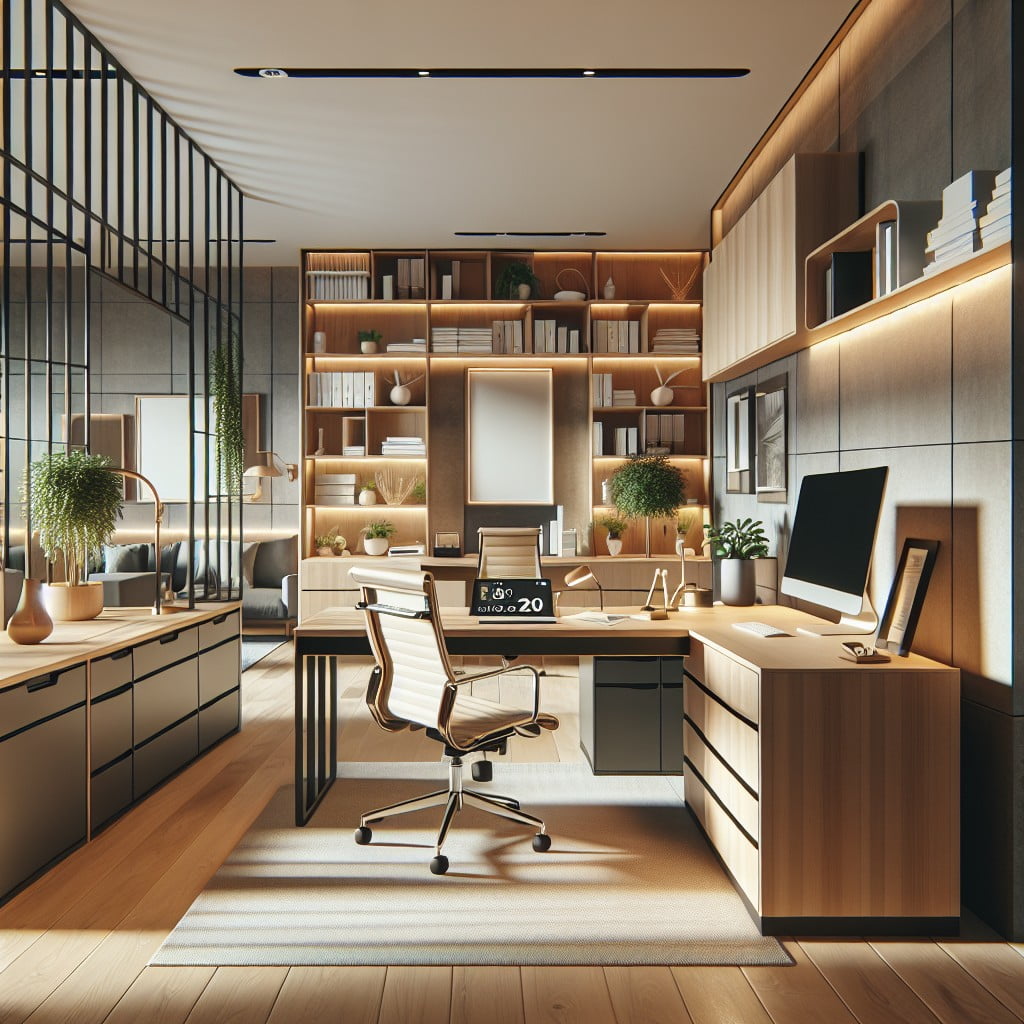
Before embarking on the design of your home office, start by evaluating the amount of space available. This will influence how you can best use the area and what furniture will fit. Consider the following:
- Dimension Check: Measure the length and width of your room to understand the size constraints. Don’t forget any alcoves or recessed areas that could be utilized.
- Work Habits: Reflect on your daily tasks. A graphic designer might require a large desk for multiple monitors, while a writer could prefer a smaller desk with space for books and notes.
- Storage Solutions: Think about the amount of storage you need. Do you prefer everything within arm’s reach or are you aiming for a minimalistic setup with less on display?
- Room’s Purpose: Determine if the office will be multi-purpose. If your office also serves as a guest room, consider a fold-out sofa or a Murphy bed.
- Tech Requirements: Identify your technical needs. Will you need numerous outlets, a place to house a printer, or room for a server? Make sure you plan for these elements from the start.
Recognizing your unique needs and the potential of your space lays the groundwork for an optimal home office design.
Ergonomic Furniture Selection
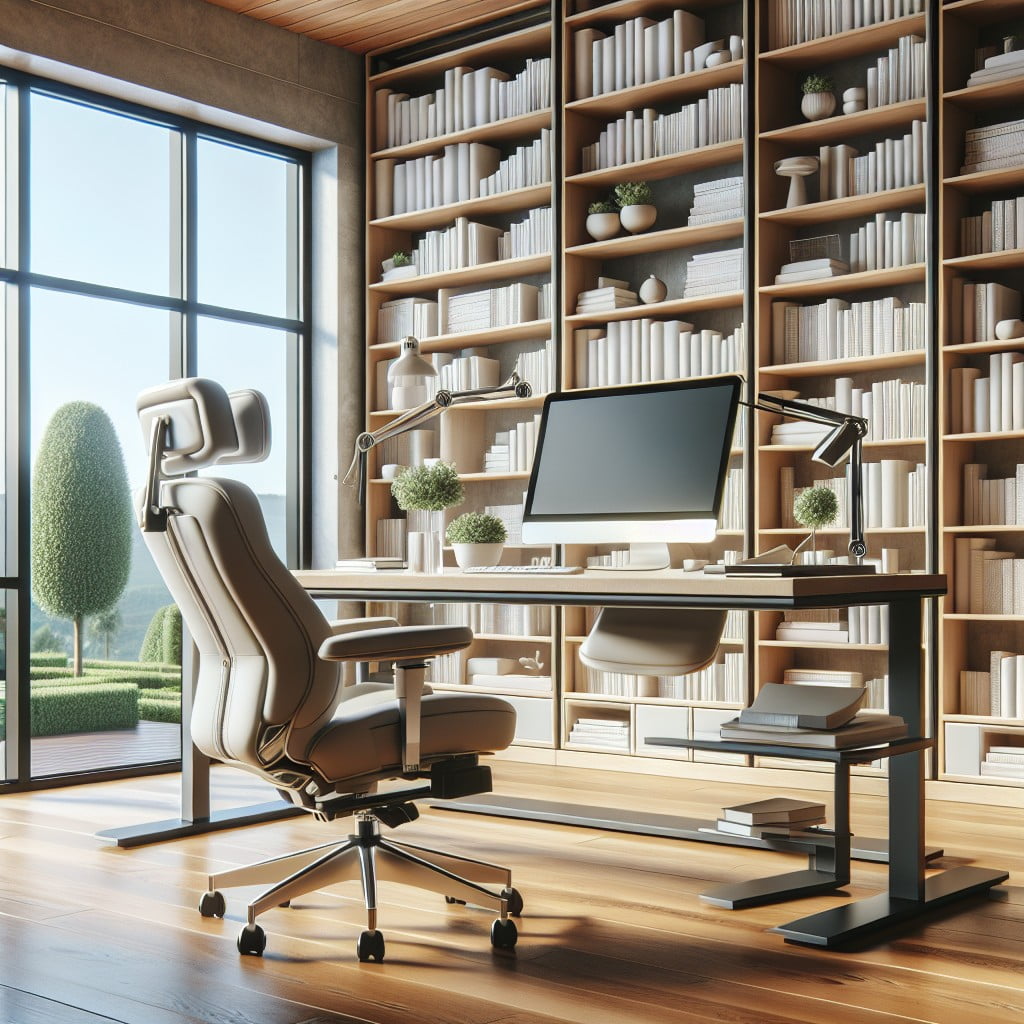
When selecting furniture for your home office, prioritize ergonomics to prevent strain and injury during long work hours. An adjustable chair that supports your spine’s natural curve is fundamental. Look for one with customizable seat height, armrests, and lumbar support.
A desk with the correct height plays a significant role too. It should allow your arms to rest comfortably at a 90-degree angle while typing. Consider a standing desk or an adjustable converter to alternate between sitting and standing, reducing the risk of sedentary lifestyle-related health problems.
Remember that keyboard trays and monitor stands contribute to a proper ergonomic setup as well. They help maintain an optimal distance from your screen and keep your wrists flat when typing, which can help in avoiding repetitive strain injuries.
An ergonomic environment not only enhances comfort but also increases productivity by minimizing discomfort and potential distractions. Finally, be sure to allow for enough legroom under your desk, creating a clutter-free space where your legs can move freely, helping with circulation and overall comfort.
Desk Placement and Orientation
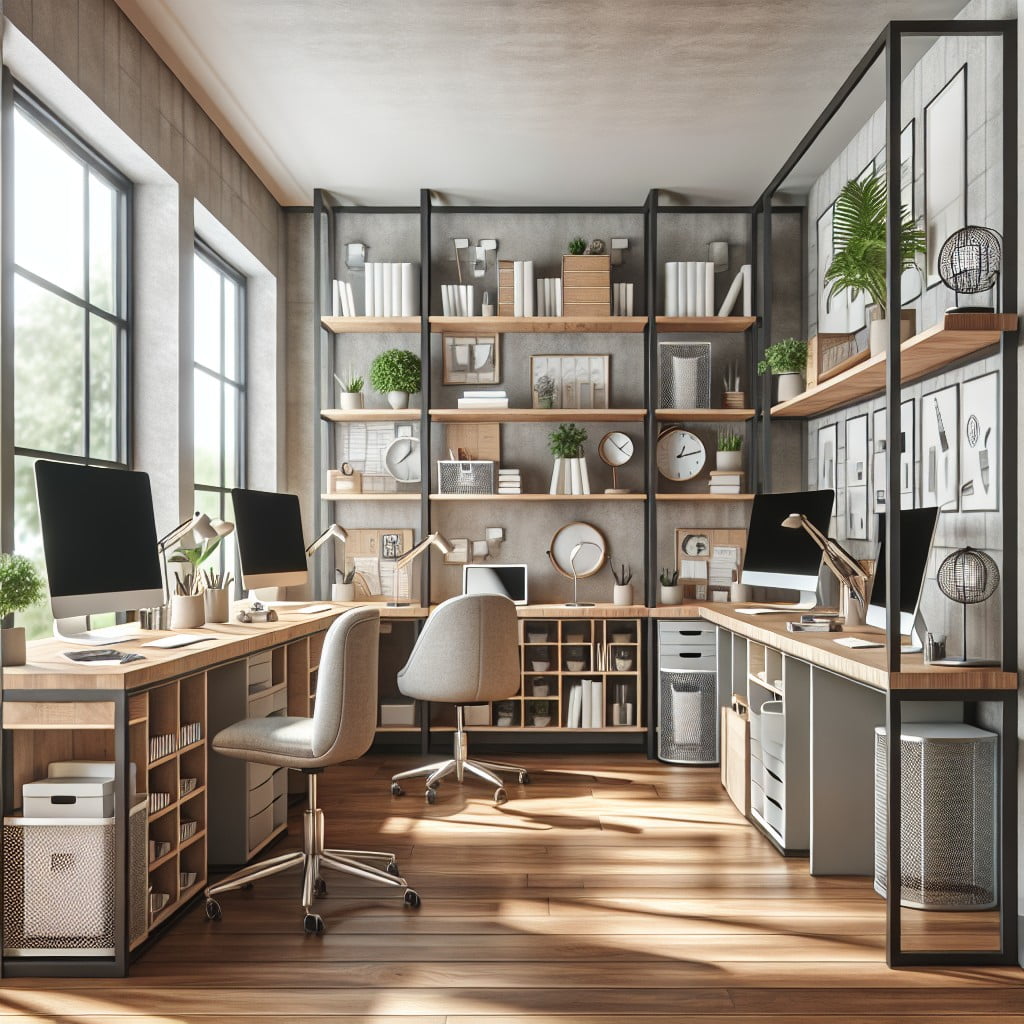
Choosing the right spot for your desk can have a significant impact on workflow and comfort. To harness natural light without the interference of glare, position your desk parallel to the window. This layout avoids shadows and decreases eye strain from artificial lighting. If your window placement doesn’t allow this, consider having your desk face the window, balancing the light with adjustable blinds or sheer curtains.
Consider the desk’s relation to the door as well. Placing it too close may disrupt focus with frequent passersby. If possible, the ideal location is a view of the door without being in the direct line of traffic. This placement maintains a sense of privacy and control over your environment.
For video conferences, wall backdrops are crucial. Orient your workstation so there’s a tidy, uncluttered wall behind you, which projects professionalism and reduces visual distractions for others during calls. Remember to test out camera angles and lighting before finalizing the desk position.
Finally, factor in power outlet locations to avoid unsightly cords trailing across the room. The more accessible your outlets are, the easier it is to keep your space tidy and your tech powered. If built-in solutions are an option, consider customizing your desk with integrated power supplies.
Lighting Considerations
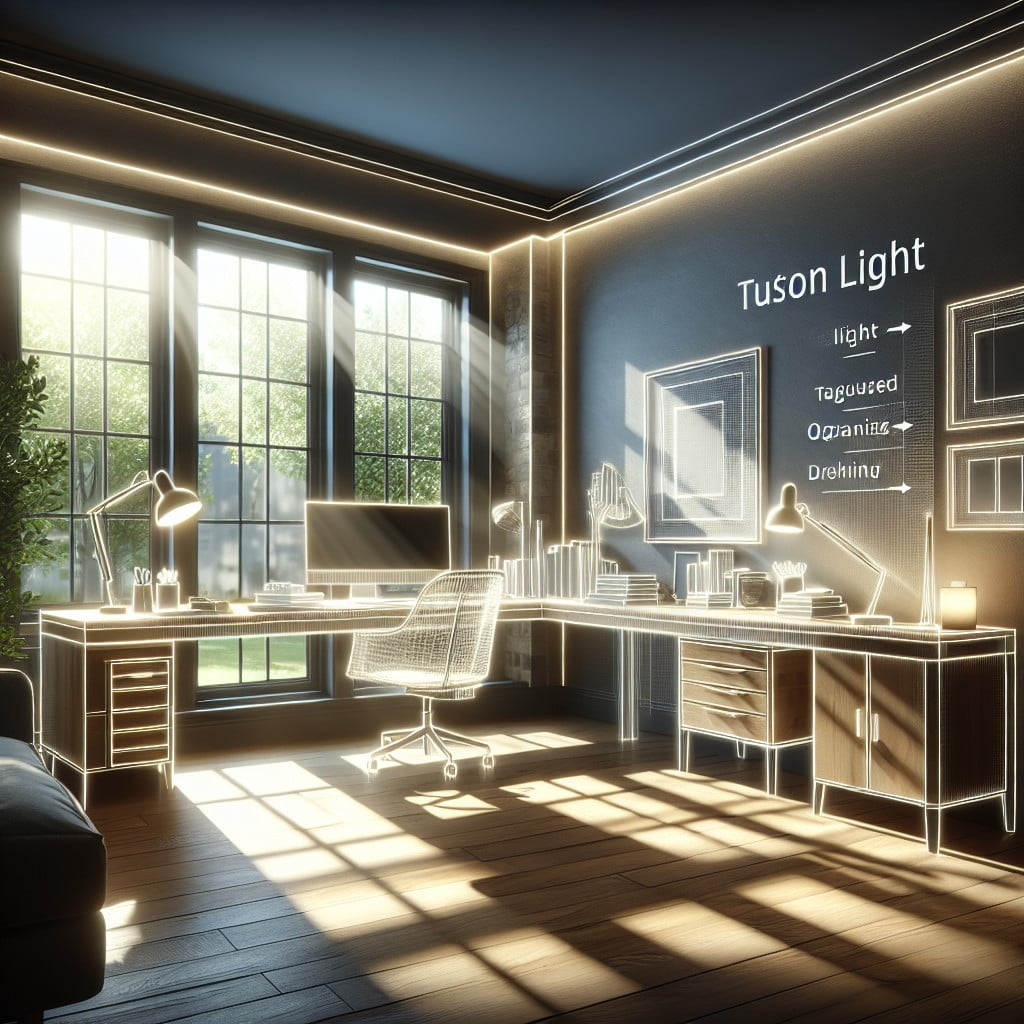
Natural light should be maximized to enhance mood and productivity; position your desk to take advantage of any windows without causing glare on your computer screen. Task lighting, such as a dedicated desk lamp, is crucial for focused work, especially in areas that the overhead light doesn’t reach. LED lights offer a longer lifespan and can mimic natural daylight, helping to reduce eye strain during long working hours.
Consider dimmable options to adjust the brightness according to the task at hand or time of day. Additionally, ambient lighting can contribute to a calm and inviting office environment, so adding floor or table lamps can soften the space. Remember to choose bulbs with the right color temperature – cool whites can help maintain alertness, while warm whites may be better for reading or softer ambiance.
Aesthetic and Style Preferences
Harmonizing your workspace with your home’s existing decor infuses a sense of continuity and personal flair. Consider a color palette that promotes productivity while resonating with your individual tastes—neutrals can soothe, while bold hues might energize. Selecting materials and finishes that reflect your style, from sleek metals and glass to warm woods, can also be crucial for a cohesive look.
Incorporate artwork, decorative objects, or plants to inject personality and life into your area. Textural elements through rugs, curtains, and upholstery can add depth and comfort. By aligning design choices with your aesthetic preferences, your custom home office becomes a reflective sanctuary that encourages focus and creativity, maintaining a balance between professional functionality and personal comfort.
Personalizing Your Office Space
Incorporating personal touches into your home office not only enhances its appeal but can also boost your productivity and comfort. Start with wall art that inspires or relaxes you, such as framed diplomas, certifications, or personal paintings and photographs. Select a color scheme that resonates with you; calming blues and greens foster concentration, while warm yellows can energize and uplift.
Add plants to breathe life into the space and improve air quality – a snake plant or peace lily requires minimal care. Consider a display shelf for meaningful items, be they books, awards, or mementos that keep your goals and motivations in sight.
Remember, storage solutions can be both practical and personal. Choose a combination of open shelving for items you want to display and closed cabinetry for less visually pleasing essentials. Finally, infuse your distinct style with choice desk accessories that are both functional and representative of your unique taste, such as a vintage-inspired desk lamp or a handcrafted pen holder.
Choosing the Right Seating
Selecting a chair that offers lumbar support is pivotal to maintaining proper posture and ensuring comfort during long work hours.
Look for adjustable features that allow for customization to your body’s shape and preferences, including height, backrest tilt, and armrest positioning.
A chair with a swivel base can enhance mobility, reducing the need to stretch or strain to reach items.
Consider investing in a chair with breathable material to prevent overheating and a waterfall edge seat design to alleviate pressure on the backs of the knees.
Remember, a chair that feels good for a few minutes in a showroom may not hold up for an eight-hour day, so look for suppliers who offer trial periods.
Ensure the chair can fit under your desk comfortably and does not impede leg movement.
Prioritize quality and warranty; a good chair is an investment in your health and productivity.
Integrated Technology Solutions
Incorporating cutting-edge tech features can streamline your workflow and keep your desk clutter-free. Start by evaluating which devices you use daily; a dedicated charging station can be a game-changer for keeping tablets and phones powered up without a tangle of cords. Consider built-in USB ports and Bluetooth connectivity for easy syncing of devices.
When it comes to your computer setup, think about wireless peripherals. A Bluetooth keyboard and mouse eliminate additional wires and give you the freedom to work from various positions. Opt for a high-speed internet connection with a reliable router, strategically placed to ensure an uninterrupted Wi-Fi signal.
For those frequent video conferences, installing an integrated webcam and microphone set-up ensures that you’re always meeting-ready. Including smart speakers with voice assistants can help manage your calendar and set reminders without breaking your work stride.
Finally, implementing a smart lighting system that can be controlled via an app or voice command helps you adjust the light to your comfort level throughout the day, which could enhance your productivity and focus.
By embedding these technologies into your custom home office design, you’re not just preparing for the tasks at hand; you’re future-proofing your workspace for the ever-evolving digital age.
Cable Management Systems
Tangled cables can quickly turn your custom home office into a chaotic mess. To ensure a clean look and easy access to your devices, investing in a sound cable management system is essential.
Consider these options:
- Under-desk trays and raceways: These can discreetly hold and route wires, keeping them out of sight.
- Cable clips and sleeves: Stick these onto desks or walls to secure cords and prevent tangling.
- Grommets: Install these into desk holes for a streamlined way to feed cables from your devices to power outlets.
- Wireless devices: Whenever possible, opt for wireless keyboards, mice, and printers to reduce cord clutter.
- Multi-purpose power strips: Choose models with built-in cable management features to centralize power sources and minimize cord sprawl.
Implementing these simple measures can greatly contribute to a cleaner, more organized office environment, allowing you to focus on your work without unnecessary distractions.
Optimizing Vertical Space
Maximizing the height in your home office means every inch can contribute to a clean and efficient workspace. Start by installing floating shelves above your desk to keep reference materials and office supplies within arm’s reach. Consider a tall bookcase to organize additional documents and display personal items, providing both storage and a touch of personality.
For those items you use less frequently, high-mounted cabinets keep them out of your daily visual space, reducing clutter. Wall-mounted boards, either magnetic or cork, give you a place to pin important notes and to-do lists without sacrificing desk space.
Vertical space can also include your wall area for mounting monitors and speakers, which can free up desk space and help maintain a comfortable viewing height. If floor space is limited, a wall-mounted folding desk can serve as a temporary workspace that tucks away when not in use.
Last but not least, don’t forget the back of the door. With over-the-door hangers, you can hang coats, headphones, or even small storage baskets. By looking up, you discover a wealth of space-saving opportunities that make for a streamlined and highly functional home office.
Functional Flooring Options
Hardwood, with its timeless appeal and durability, remains a top choice for a luxurious and professional aesthetic. Carpet tiles, on the other hand, offer versatility, noise reduction, and comfort underfoot, making them perfect for those long hours at the desk.
Laminate provides a cost-effective alternative that’s easy to install and maintain. For the eco-conscious, bamboo or cork floors are sustainable options that also boast natural anti-microbial properties, ideal for a clean and healthy workspace.
Finally, vinyl planks or tiles can mimic the look of more expensive materials and offer an excellent balance between functionality and style. When selecting flooring, consider not just the look, but also the ease of movement for chairs, resistance to wear in high-traffic areas, and the ease of upkeep.
Window Treatments for Function and Style
Selecting the right window treatments enhances both the aesthetic appeal and functionality of a home office.
- Balancing Light and Privacy: Consider treatments that provide control over natural light and maintain privacy. Adjustable options, such as blinds or shades, offer flexibility throughout the day.
- Energy Efficiency: Thermal curtains or honeycomb blinds can help insulate the room, reducing energy costs and improving comfort.
- Color and Pattern: Choose colors and patterns that complement the room’s decor and don’t distract from work tasks. Neutral tones often work well, but a pop of color can add vibrancy to the space.
- Ease of Use: Opt for window treatments that are simple to operate, especially if you’ll need to adjust them frequently during the day.
- Material Durability: Consider durable materials that are easy to clean and can withstand direct sunlight without fading.
- Layering: Layering sheer and opaque treatments allows for light diffusion and enhanced visual depth.
Selecting treatments that meet both practical and stylistic requirements creates a conducive and pleasant home office environment.
Professional Craftsmanship
Selecting skilled artisans for your custom home office build ensures that every detail is executed with precision. Experience matters when it comes to millwork, cabinetry, and custom furniture, as these elements can greatly enhance the functionality and aesthetic of your space.
- Craftsmanship translates to quality; opting for experienced professionals often means more durable finishes and joinery that stands the test of time.
- Local artisans can provide unique touches that reflect personal style while also offering the opportunity for more tailored customer service.
- Attention to detail is paramount in a craftsperson’s work, allowing for seamless integration of your home office with the rest of your living space.
- Investing in professional craftsmanship may have a higher upfront cost but typically results in greater satisfaction and fewer issues down the line.
Handling Legal Requirements
Before commencing work on your home office, ensuring compliance with local building codes and zoning laws is crucial. Here are key points to guide you through this process:
1. Obtain necessary permits: Depending on the scale of your office construction or renovation, certain permits may be required. Check with your local government for specifics.
2. Zoning regulations: If your home is located within city limits, zoning laws may impact the extent of your office build. These laws can affect things like the size of your office and whether clients can visit.
3. Tax implications: Designating a portion of your home as an office can lead to potential tax deductions. However, specific criteria must be met, and it’s advised to consult with a tax professional.
4. Contractor credentials: Hire licensed and insured professionals to avoid legal or financial issues in case of accidents or construction faults.
5. Homeowners’ association rules: If you’re part of a homeowners’ association, check their guidelines for external changes or home business operations, which may require approval.
6. Insurance: Verify with your insurer that your home office and equipment will be covered under your current policy. Additional coverage might be necessary.
Take these steps seriously to sidestep any legal hurdles that might interrupt the creation of your home office.
Creating a Multi-functional Space
Blurring the lines between work and relaxation within a home office is essential for those who seek versatility in their workspace. To achieve a multi-functional space, consider incorporating a convertible desk that can transition between standing and sitting. Adding a sofa bed can cater for quick power naps or serve as guest lodging. Built-in shelving units that house both professional references and personal collections enable a seamless switch in ambience. Consider a pull-down screen for video conferencing that retracts to reclaim the room’s casual nature when the workday ends. The use of room dividers or decorative screens provides a physical separation of the work area from the rest of the room, making it conducive to both focused tasks and leisure activities as needed.
FAQ
What is a California closet?
A California closet refers to a custom closet or storage system manufactured by the company California Closets, available through its franchised showrooms across the United States, Canada, Mexico, Puerto Rico, and the Dominican Republic.
Where is the best place to set up a home office?
The guest room and the basement are considered the best places to set up a home office, due to their ability to provide a segregated workspace that keeps personal and professional life separate.
What are the essential elements for a productive custom home office?
The essential elements for a productive custom home office include ergonomic furniture, ample natural light, effective storage solutions, sound insulation, reliable internet connection, tech tools, and personalised decor to create a motivating work environment.
How can ergonomics be applied in the design of a custom home office?
Ergonomics can be applied in the design of a custom home office by adopting adjustable furniture such as chairs and desks with proper height and angle provisions, ensuring an adequate lighting system to prevent eye strain, and arranging all equipment at reachable distances to promote comfort, efficiency, and safety.
What are some space-saving ideas for a small custom home office?
Implementing foldable desks, vertical storage, wall-mounted shelves, multi-purpose furniture, and utilizing corners effectively are practical space-saving ideas for a small custom home office.
Recap:


